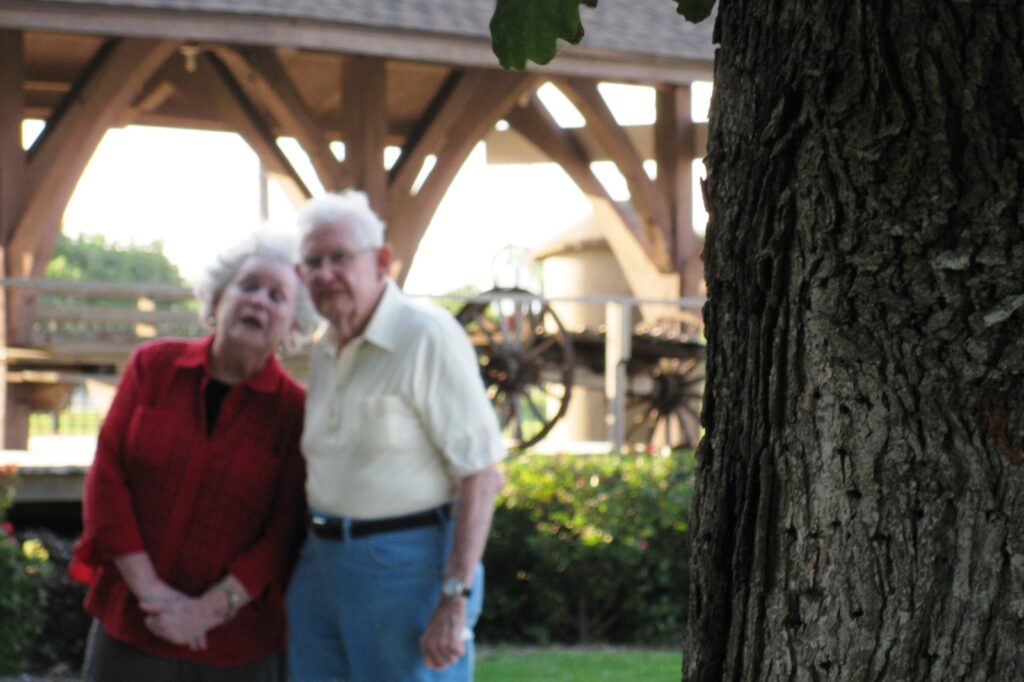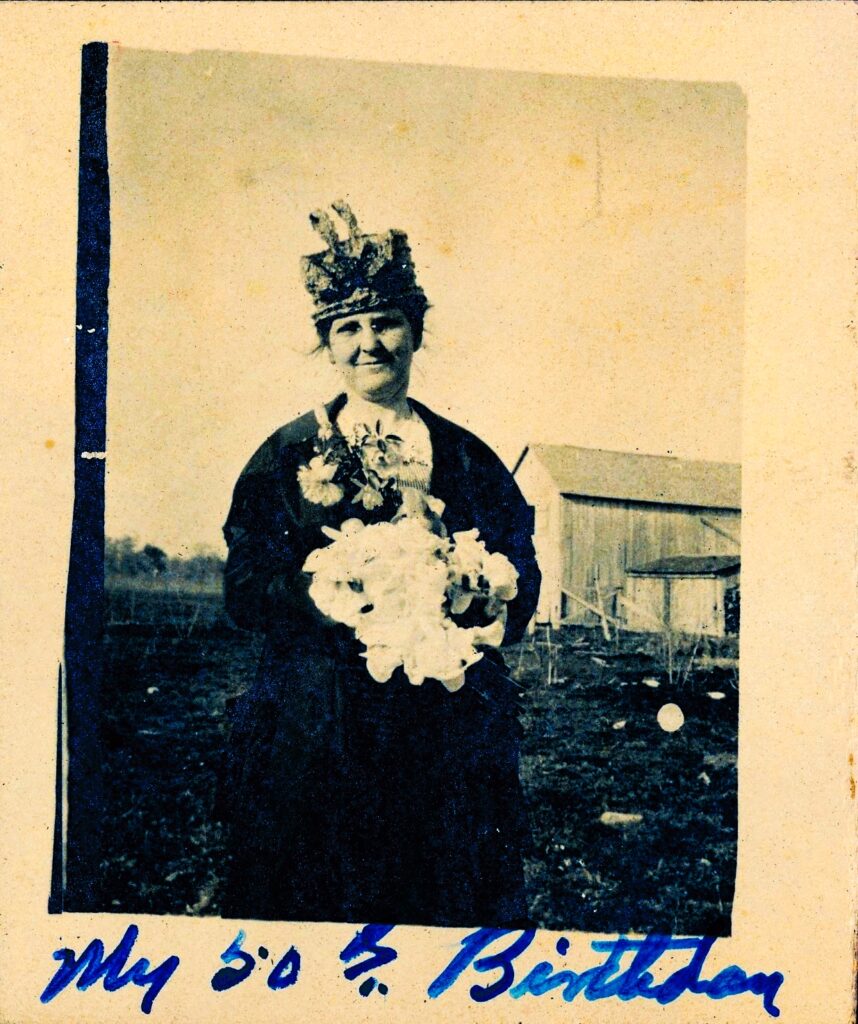La Porte’s First Movie Houses
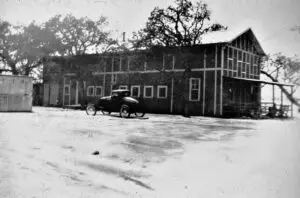
Broadway Theater at Five Points, La Porte, Texas, December 1926
Between 1913 and 1930, La Porte, Texas, saw several entrepreneurs enter the movie theater business. However, the Great Depression, which began in the summer of 1929 and lasted into the late 1930s, had a severe impact on the movie industry. As a result, small movie houses across the country were significantly affected, and many were forced to close or find alternative ways to operate.
By 1930, following these trials, the last of the early La Porte theaters closed, leaving the town without a movie house until 1936. Meanwhile, the entertainment industry was booming and provided the American people with a distraction from their difficulties. For La Porte residents, however, this meant travelling to Houston or north across the Ship Channel to see a film to experience the diversion a movie provided.
Howard E. Brunson

Arcadia Theater in Baytown (circa 1928)
While La Porte theaters were shuttered, that was not the case on the north side of the Ship Channel. A mercantile owner named Howard E. Brunson ventured into the movie theater business in 1925. Even though he faced setbacks with his first partnership experience owning and operating a theater, he discovered a passion for the industry and “found the fruit sweet.” Soon, he purchased a piece of property on Main Street in Baytown and built the Palace Theater, which opened its doors in 1925 and continued operating until 1929.
This venture proved to be a significant success, leading Brunson to realize that he needed to leave the merchandise business to focus exclusively on the theater business. Consequently, in December of 1928, he opened the newly constructed Arcadia Theater.
Notably, the new movie house totaled approximately $33,000 in costs to construct, with furnishings and equipment adding another $65,000 to the expenses. Brunson promised to provide his patrons with “only the very best of entertainment.” With this commitment, the theater featured sound pictures, making it the first in the area to install such technology. As a result, Brunson became the owner of two successful theaters.
East Texas Theaters and H.E. Brunson Partnership
In 1932, East Texas Theaters, a subsidiary of The Jefferson Amusement Company of Dallas, acquired Brunson’s Arcadia Theater. East Texas Theaters emerged as a major player in the entertainment landscape of East Texas, known for owning and operating multiple movie houses while often collaborating with other theater entities like Jefferson Amusement.
Considering this partnership, Brunson collaborated with East Texas to establish the firm, East Texas Theaters and H.E. Brunson. Shortly after its formation, the organization expanded by acquiring the Texan in Baytown in 1932, and the DeLuxe in 1934, followed by the Alamo in Pelly in 1937. By this time, East Texas Theaters and H.E. Brunson had solidified their position as the sole operators of movie theaters in the Tri-Cities.
New Theater For La Porte

Port Theater, 200 Block of West Main Street, La Porte, Texas (circa 1938)
In 1936, East Texas and H.E. Brunson expanded their operations south across the Ship Channel, leasing property on Main Street in La Porte. Construction soon began on the first Port Theater in the 200 block of West Main Street, with the building and equipment costing $15,000 and seating 500.
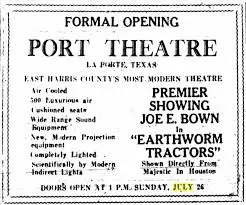
1936 Port Theater opening advertisement
The entertainment industry continued to expand, and by early 1937, East Texas Theaters announced a significant personnel promotion within their Tri-Cities operations. Specifically, the former assistant manager at the Arcadia Theater in Baytown, L.R. “Doodle” Rigby, was promoted to manager at the DeLuxe in Baytown, succeeding Arthur Patureau, who had transferred to manage the Arcadia. At this time, Alvin Cunningham managed the recently opened Port Theater in La Porte.

Arthur Patureau, Port Theater manager (circa 1938)
However, Cunningham did not remain long in this position and was replaced by Patureau, who took over management of the Port in late 1937. Notably, Patureau, an artist, was responsible for creating most of the large poster advertisements and designing the grand displays for the shows. He, in turn, was replaced by Rigby in 1938.
Port is Modernized
In 1941, recognizing the need for modernization, East Texas Theaters undertook a remodeling of the Port Theater. They painted the building’s front, and notably, the cashier’s office was relocated from the center to the side, enhancing the overall entrance. In a proactive response to the growing Civil Rights movement, East Texas Theaters and Brunson made a significant step by integrating access for the African American community. They installed an outside entrance on the building’s exterior leading to the balcony, thereby promoting equality and inclusiveness.
L.R. “Doodle” Rigby had taken on the role of manager during this time.
World War II
With the onset of World War II, the United States entered the conflict on December 8, 1941. Several months later, Rigby enlisted in the Army. During his absence, East Texas Theater’s district managers, Rufus Honeycutt and Nathan Hanson, alternated in managing the Port Theater to ensure its continued operation.
Post-War Expansion

Brunson Theater on Texas Avenue in Baytown, Texas. (circa 1950)
Following the war, the population of the Tri-Cities area saw considerable growth. In the spring of 1947, East Texas and Brunson initiated a $300,000 expansion program for East Harris County. By July, construction began on a $100,000 movie house in the 300 block of West Texas Avenue in Baytown. Named the Brunson Theater, it featured a seating capacity of 1,510, and notable enhancements included being air-conditioned and fireproof. At that time, Rufus Honeycutt served as the manager, while H. E. Brunson held ownership.
Then, in the summer of 1947, the expansion program extended to La Porte. After fifteen years of operation, the original Port Theater in La Porte became inadequate and began to deteriorate, leading to the construction of the “new” Port Theater.
“New” Modern Port Theater
By 1947, Rigby, having been discharged from the service , returned to his position as manager of the Port Theater. After overcoming various construction delays that extended construction close to a year, the “new” modern Port Theater held its grand opening ceremony on September 16, 1948. This momentous occasion featured speeches by La Porte Mayor Pfeiffer and H. E. Brunson, marking a new chapter in the theater’s history.
, returned to his position as manager of the Port Theater. After overcoming various construction delays that extended construction close to a year, the “new” modern Port Theater held its grand opening ceremony on September 16, 1948. This momentous occasion featured speeches by La Porte Mayor Pfeiffer and H. E. Brunson, marking a new chapter in the theater’s history.
At the time, the new $60,000 movie house had the most modern safety equipment of any theater in the area. For instance, the back doors had the latest type of fire locks, and the chemically treated screen was fireproof, roachproof, and ratproof. In addition, the projection room was also completely fireproof.
There was also a private soundproof room seating eleven, for mothers who brought their babies. Nicknamed the “Cry Room,” it featured a large glass window at the front of the room, allowing mothers to see the movie while attending to their young children, without disturbing other moviegoers.

Port Theater, inside view. The Houston Chronicle Special Edition, September 16, 1948
On a related note, the theater included a confectionery counter situated in the main lobby, near the entrance.
Furthermore, the theater had a $15,000, 8-ton air conditioning unit, which enabled patrons to be completely comfortable in both summer and winter. Lights attached to the seats illuminated the aisle, and the main house lights provided indirect and dimmable lighting, with the bulbs concealed to prevent glare.
The projection room was equipped with the latest model projection equipment, equal to that of any theater of its size. The seats, in particular, were modern and cushioned, providing comfort for the audience. The auditorium’s seating capacity was 900.
The interior design included a half-circle stage large enough to accommodate a stage show. Gold and maroon curtains, controlled electrically from the projection room, framed the stage. The loudspeaker was located directly behind the screen, rather than over it, as in less modern theaters. Thus, the sound equipment was thoroughly modern in every aspect, consisting of two amplifiers that were capable of being used together or separately.
The feature film shown at the Grand Opening was the Technicolor movie Lady in Ermine, starring Betty Grable and Douglas Fairbanks, Jr., along with selected short subject reels. The ticket price was forty cents.
Drive-In’s Enter the Scene
The drive-in movie theater was patented in Camden, New Jersey, on May 16, 1933, by Richard M. Hollingshead Jr., a movie fan and sales manager for his father’s company, Whiz Auto Products. Originally called “Park-In Theaters,” the drive-in’s popularity grew after World War II.
In 1948, there were fewer than one thousand drive-in theaters across the country. However, by 1958, there were almost five thousand in the United States and 300 in Canada.

USGS map showing the location of Decker Drive-In
Drive-in movie theaters allowed families to watch films from the comfort of their cars, thus merging the public’s interest in entertainment with their love of automobiles. Consequently, providing a place to enjoy affordable public entertainment in a safe, family-oriented environment. Notably, when the Decker Drive-In Theater opened on Decker Drive in Baytown on March 29, 1949, it was one of the most modern theaters of its type in the area.
 Later on, in 1951, Johnny Myers of Pasadena and M.K. McDaniels of La Marque built a drive-in theater along Highway 146, northwest of downtown La Porte. Afterward, the drive-in, later named The Colonial, became part of the East Texas Theaters and Brunson group in 1953. The drive-in was remodeled and upgraded in May of 1966.
Later on, in 1951, Johnny Myers of Pasadena and M.K. McDaniels of La Marque built a drive-in theater along Highway 146, northwest of downtown La Porte. Afterward, the drive-in, later named The Colonial, became part of the East Texas Theaters and Brunson group in 1953. The drive-in was remodeled and upgraded in May of 1966.
Port Manager L. R. Rigby
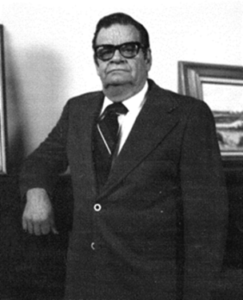
Louis R. “Doodle” Rigby, circa 1970
At the age of 15, L.R. “Doodle” Rigby began his career in the movie industry at the Queen Theater in Victoria, where he worked as a doorman and usher. Quickly, he learned how to operate the projection booth and gained experience in several locations, including Seguin, Lufkin, Henderson, and Bastrop. Rigby left the Strand Theater in Bastrop to begin his career as a projectionist with the Jefferson Amusement Company on Halloween Day, 1936.
Following that, Rigby’s first assignment as a manager was at the Arcadia Theater on Market Street in Baytown in 1937. After transferring to various other East Texas properties, he became manager of the newly constructed Port Theater in La Porte in 1938.
In 1942, Rigby enlisted in the Army shortly after the start of World War II. After being discharged in January 1946, he soon returned to his employment with East Texas Theaters. In the summer of 1947, Rigby transferred back to La Porte to manage the Port Theater. Around that time, the Rigby family moved to La Porte, while the new, modern theater was under construction.
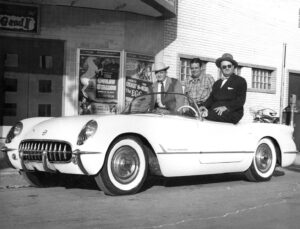
L to R: H.E. Brunson, L.R. Rigby, and George McMillan of McMillan Chevrolet, riding in a new Chevy Corvette for the Grand Opening of the Port Theater September 16, 1948.
Additionally, Rigby was active in the La Porte community, volunteering his time to various activities, including serving as Chairman of the 1954 March of Dimes collection effort and as a member of the Chamber of Commerce and the Rotary Club.
 As a side note, when film star Dorothy Lamour visited the Port Theater in 1949, Rigby removed the seat where she sat to preserve it for posterity.
As a side note, when film star Dorothy Lamour visited the Port Theater in 1949, Rigby removed the seat where she sat to preserve it for posterity.

The Houston Chronicle, September 27, 1957
Furthermore, Rigby served as a City Commissioner from 1952 to 1958, when the city government consisted of a mayor and two commissioners. When Mayor Mercer Burgin died suddenly in September 1957, Rigby was mayor pro tem and served as mayor along with fellow commissioner, H.P. Pfeiffer, until La Porte elected a new mayor. Consequently, he resigned as a La Porte city commissioner to run as one of four candidates for mayor in the April 1958 election.

The Houston Chronicle, September 28, 1957
Except for the few years Rigby served in the military during World War II, he was the manager of the Port Theater—both old and new—until 1974, when he became the district manager at the Brunson Theater, and later the Bay Plaza Theaters in Baytown.
Theaters Face Competition
By the 1950s, attendance in movie theaters faced competition from television, and ticket sales declined. In January of 1954, Brunson published a message in The Baytown Sun, expressing his observations over several months about the decrease in theater patrons. He noted that many people preferred to stay home and watch television, which had become a recent novelty, rather than going out with their families.
Brunson emphasized his belief that “when people stay home, they soon dry up and die.” He highlighted the importance of movie theaters as spaces for socializing and maintaining consistent contact with others, which helps prevent isolation and boredom. He recommended that people dress up at least once a week and attend a good show at their neighborhood theater. For Brunson, the theater was one of the best places to find happy people.
We either put something on or take something off when we rub shoulders with people. The theater is one of the best places to find happy people…try it twice a week…rub a little good off you on to someone else.
-Howard E. Brunson
As a result of declining attendance, movie theaters in Harris County and other parts of the country began offering moviegoers a more immersive experience, like Cinerama. Cinerama theaters employed a unique process that utilized three synchronized projectors, each displaying one-third of the picture onto a wide, curved, massive screen. The first Cinerama theater in Houston was the Windsor Theater, which opened in December 1962.
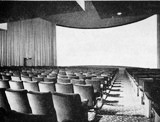
Windsor Theater’s Curved, Wide Screen

Windsor Theater Auditorium’s Stadium Seating
Enter the Multiplex
Changes within the movie industry continued to progress during the 1960s, with widescreen Cinerama and multi-screen theaters becoming a popular part of public entertainment. Stanley Durwood of Kansas City, son of Edward Durwood, one of the founders of Durwood Theaters, came up with the idea around 1961 of adding a second screen to one of its theaters. By doing so, the movie theater continued to operate with the same staff while showing twice as many movies. Ultimately, he opened the first multiplex in the country in Kansas City.

Town & County 6 Theatres, which were torn down in 2002.
In April 1965, General Cinema opened Houston’s first multiplex theaters with twin cinemas at Gulfgate, Meyerland, and Northline Malls.
In 1968, Durwood Theatres rebranded as American Multi-Cinema, or AMC Theatres. Recognizing the success of the multiplex theater, AMC entered the Houston market in 1969. The AMC multiplexes featured multiple screens and a selection of first-run movies. AMC opened three multiplexes on Christmas Day 1969: The Town & Country 6, Northwest 4, and Almeda 4, which was located just over 15 miles from La Porte.
Brunson and Jefferson Amusement Sell
In another development, the Jefferson Amusement Company and H.E. Brunson of East Texas Theaters sold 33 South Texas theaters in 1968, including the Brunson and Port, as well as the Decker and Colonial Drive-Ins, to Golden Triangle Theaters, Inc. Gulf States Theaters of McComb, Mississippi, whose business focus in the motion picture industry was as a distributor and management, operated all the movie houses on their behalf.
The Last Picture Show

Rufus L. Honeycutt, Brunson Theater Manager, retired in 1974
Not one day since it opened on September 16, 1948, has the Port Theater closed its doors. Through strikes, 3D pictures, good and bad movies, and even serving as a shelter following Hurricane Carla in 1962, its doors were always open, and Mr. Rigby was a constant presence.
However, the advent of multiplex and Cinerama theaters transformed the traditional format for movie productions and the way audiences experienced movies. This rise of multiplexes, coupled with competition from television, the VCR, and later cable TV, took its toll on older, single-screen theaters such as the Port.

H. E. Brunson, owner of the Brunson Theater, passed away in 1977.
By 1974, Rigby had moved on to become the district manager for TerCar Theaters and Brunson. The small-town picture show was becoming a thing of the past, closing one by one across the United States. Regrettably, the Port Theater could not escape its inevitable fate.
On October 1, 1978, the last movie shown at the Port Theater was Grease, starring John Travolta and Olivia Newton-John.
End of an Era
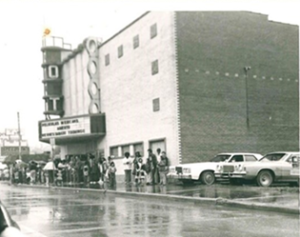
Port Theater showing Spanish-speaking movies, 1983
In the years that followed, the Brunson Theater closed its doors in 1982, and the Port briefly showed Spanish-speaking films in 1983, but it soon closed as well. Sadly, on March 17, 1983, L. R. “Doodle” Rigby passed away.
Since its closing, the old Port Theater building has served as a venue for various forms of entertainment. Around the 1990s, the building was remodeled, opening as the Werner-Robinson Theater featuring venue events, and then as the Confrontation Church in Christ.
Over the years, multiple individuals have purchased the building in hopes of refurbishing and restoring it as a theater or entertainment center, but the task has proven too costly.
“This Place Matters”
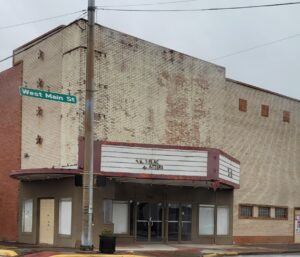
Port Theater on Main Street, La Porte, Texas, as of 2023
As of 2025, the building still stands at the northeast corner of Main and 4th Street, a monument to La Porte’s history and a fading shadow of its former glory days.
As the marquee once said:
“This Place Matters.”
By Georgia A. Malone
August 8, 2025
©️2025 Georgia A. Malone. All Rights Reserved.
Resources:
“Picture Shows,” written by Gertrude Ackerly, Gertrude Ackerly Archives (1914-1962), Unpublished manuscript of History of La Porte, Texas.
“Heritage Society Presents La Porte: The First Picture Show,” The Bayshore Sun (La Porte, Texas), October 4, 1979.
“Movie Binder,” Mary Ann Uloth Malone Collection, various Port Theater and Colonial Drive-In Theater photographs and advertisements (1936-1986).
“Underwood-Rigby 1947,” by Virginia Underwood Rigby, Summer Folks ‘n Year-Round Neighbors, p. 310-311, La Porte Bay Area Heritage Society, La Porte, Texas, September 11, 1992.
“Formal Opening of East Baytown Theatre Planned,” The Houston Chronicle (Houston, Texas), December 17, 1928, p. 10, https://
www.newspapers.com
“$15,000 La Porte Motion Picture Theatre Opens,” The Houston Chronicle (Houston, Texas) July 27, 1936, p. 11, https://www.newspapers.com
“La Porte Has Rapid Growth in Five Years,” The Houston Chronicle (Houston, Texas), September 27, 1936, p. 35, https://www.newspapers.com.
“Theater Men Are Promoted,” The Marshall News Messenger (Marshall, Texas), October 23, 1936, https://www.newspapers.com.
“New Managers for Theaters Announced,” The Houston Chronicle (Houston, Texas), June 3, 1937, https://www.newspapers.com
“East Harris Theatre Heads Are Changed,” The Houston Chronicle, (Houston, Texas), February 25, 1938, http://www.newspapers.com.
“East Harris Theatres to Aid Greek Relief,” The Houston Chronicle, (Houston, Texas), March 27, 1941, p.42, https//www.newspapers.com.
“La Porte Reaches Quota,” The Houston Chronicle, (Houston, Texas), November 30, 1941, p. 9, https://www.newspapers.com.
“Mayor of La Porte Won’t Be Candidate; Two Others Ask Post,” The Houston Chronicle, (Houston, Texas), March 29, 1942, https//www.newspapers.com.
Burial Services Set for Joe C. Clemmons,” Dallas Morning News (Dallas, Texas), July 13, 1942, https://www.newspapers.com
“Theater Men Launch Big Bond Drive,” Dallas Morning News (Dallas, Texas) August 25, 1942, https://www.newspapers.com
“Rufus Honeycutt to Direct Victory Fund Drive in La Porte,” The Houston Chronicle, (Houston, Texas), March 21, 1943, https://www.newspapers.com.
Port Theater Handbill, week of April 10, 1943.
“Bond Drive,” The Houston Chronicle, (Houston, Texas), February 10, 1944, p.5, https://www.newspapers.com.
“25,000 Sold at La Porte,” The Houston Chronicle, (Houston, Texas), July 6, 1944, https://www.newspapers.com.
“Shrine Party Is Set At La Porte Tonight,” The Houston Chronicle, (Houston, Texas), December 18, 1946, https://www.newspapers.com.
“Two Legion Benefits,” The Houston Chronicle, (Houston, Texas), April 24, 1947, https://www.newspapers.com.
“East Texas Theatre Chain Buys Interest in Beaumont Firm,” The Houston Chronicle, (Houston, Texas), July 3, 1947, https://www.newspapers.com
“La Porte Building In 1948 to Go All Out,” The Houston Chronicle, (Houston, Texas), December 21, 1947, p.47, https://www.newspapers.com.
“Baytown Theatre Project Due to Be Started This Week,” The Houston Chronicle, (Houston, Texas) July 15, 1948, https://www.newspapers.com
“Said To Be County’s Finest Theatre,” The Houston Chronicle, (Houston, Texas), Special Edition, September 16, 1948.
Hovey, Julian, Photographer, Photographs of the Port Theater, 1948.
“Movie Firms Given Setback,” Dallas Morning News, (Dallas, Texas), May 10, 1949, https://www.newspapers.com
“Twister Rips Into La Porte Injuring 12,” The Houston Chronicle, (Houston, Texas), February 12, 1950
Broun, Susannah L. (2022) “Panic at the Picture Show: Southern Movie Theatre Culture and the Struggle to Desegregate,” Swarthmore Undergraduate History Journal: 3 (2), 4-23. 10.24968/2693-244X.3.2.1, https://works.swarthmore.edu suhj/vol3/iss2/1



